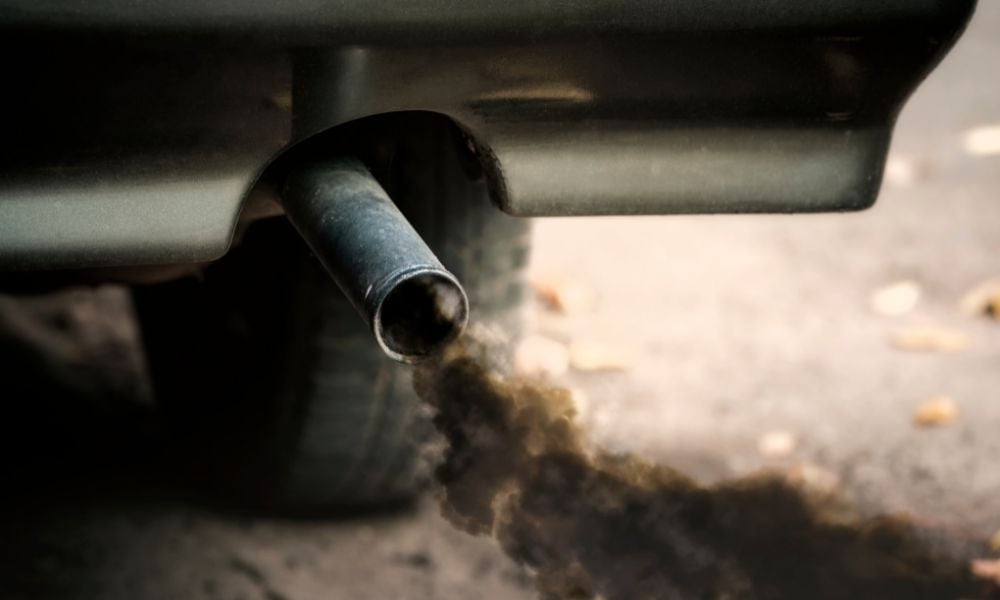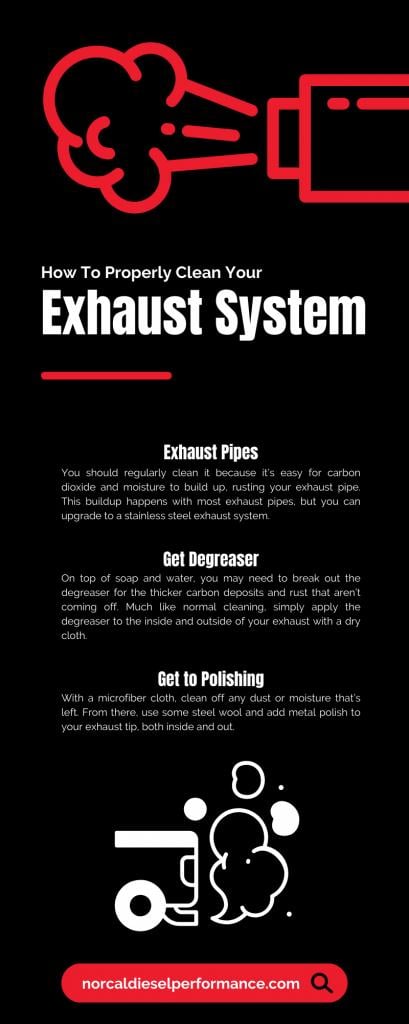


The exhaust system in your vehicle is one of the most important parts, taking the toxic fumes from your engine’s combustion and redirecting them away from your vehicle. It’s an important process, but it’s also a dirty one, and without the right cleaning, it’s easy for your exhaust system to get dirty. Thankfully, properly cleaning your exhaust system is also somewhat easy—you just need to know about your different components and the best way to clean each.
One of the first and easiest things you can clean in your exhaust system is the exhaust pipe. It’s the most visible part of your exhaust system, extending off the end of your bumper or nestled right underneath it. You should regularly clean it because it’s easy for carbon dioxide and moisture to build up, rusting your exhaust pipe. This buildup happens with most exhaust pipes, but you can upgrade to a stainless steel exhaust system. A system like this doesn’t rust or develop a carbon buildup, but you should still clean it regularly with soap and water.
To properly clean your exhaust pipe, you first need to turn your truck off and let it cool. If you try cleaning a hot exhaust pipe, you could burn yourself or inhale toxic fumes. After letting your truck cool down, you can collect your soap, water, and a clean cloth. From there, you can clean your pipe’s exhaust tip and exterior, but getting inside is another issue entirely.
If you want to clean inside the exhaust pipe, you’ll need to use a long, bristled brush. With this brush, you can go into the tailpipe as far as possible, scrubbing all along the way. You can’t get too far, but you can get deep enough to give the pipe a good cleaning with your soap and water mixture.
On top of soap and water, you may need to break out the degreaser for the thicker carbon deposits and rust that aren’t coming off. Much like normal cleaning, simply apply the degreaser to the inside and outside of your exhaust with a dry cloth. From there, you must let your degreaser sit for as long as the brand tells you. After that time is up, it’s time to use some steel wool to rub the degreaser off and, hopefully, the carbon and rust off with it. Work the steel wool in circular motions if you don’t want to scratch or further damage your exhaust pipe.
After this point, your exhaust pipe should look clean, but if you want to take it to the next level, break out some metal polish. With a microfiber cloth, clean off any dust or moisture that’s left. From there, use some steel wool and add metal polish to your exhaust tip, both inside and out. Each brand requires you to leave the polish there for some time. After letting it sit, use the microfiber cloth to brush off the polish, leaving you with a nice, clean, and polished exhaust pipe.
One of the more important components in your exhaust system that can be tricky to clean is your catalytic converter. This component removes dangerous particulate matter before it leaves your tailpipe, but carbon can quickly build up and clog the filters in this component. With a clog here, your engine won’t run properly.
However, before jumping into cleaning the catalytic converter, you can see if you need to remove it first. You can clean it without removing it, but if there are loose parts inside, you should remove them. One way to check if there are loose parts is by simply hitting the catalytic converter with something like a hammer. Doing this will rattle any parts that may be loose, and if you do hear rattling, it’s time to remove the piece entirely and inspect it further.
If everything is okay and there aren’t any loose parts, you can start cleaning out your catalytic converter with a catalytic converter cleaner. Depending on your catalytic converter cleaner, you will need to wait until you have a certain amount of gas before pouring the cleaner into your gas tank. It’s important to read the instructions here. Some brands may say you need to have about four gallons of gas in your tank, and you may not need to pour the whole bottle in. This cleaner should break down the buildups in your catalytic converter, but if your check engine light is on, you should take your car to the mechanic to finish the job.
In addition to your exhaust pipes and the catalytic converter, you should clean out your combustion manifold. This part collects the different exhausts from your engine, and all that carbon, rust, soot, and grease adds up. It’s the exhaust manifold’s job, but after a certain amount of time, it simply becomes too much, and the manifold becomes less efficient, hurting your vehicle’s performance in the process.
The first step in cleaning your exhaust manifold is removing it. Depending on your engine, you could even have two manifolds to remove and clean. Like every other component, ensure your vehicle has cooled enough before opening the hood and touching anything. After everything’s cooled, remove the hoses and bolts keeping the manifold in place, and then you can safely remove the exhaust manifold.
To give your exhaust manifold the cleaning it needs, coat the inside of your manifold with lacquer thinner. In the lacquer, you can use steel wool or a wire brush to scrub at the coated spots of your manifold. If some parts of debris are still really thick and not letting up, you can use an electric grinder to break them up. Make sure to cover the entire manifold with the lacquer, and then just let it sit for a while until you’re happy with how everything looks. After this, you just need to clean off the lacquer, and then you can reinstall your manifold, carefully matching the ports to the cylinder heads.
It’s important to know how to properly clean your exhaust system because, without the right and routine cleaning, it can quickly clog up and hurt your truck’s performance. Another reason that cleaning is important is that it will extend the life span of your exhaust parts. When you’re down there, you can see when a piece is breaking or broken and needs replacing. If you’ve found a piece like that, visit Norcal Diesel Performance. We’ve got all the exhaust parts you’ll need, including Cummins exhaust parts that can sometimes be hard to find. When you need something for your truck, we’ve got you covered.

You must login to post comments.